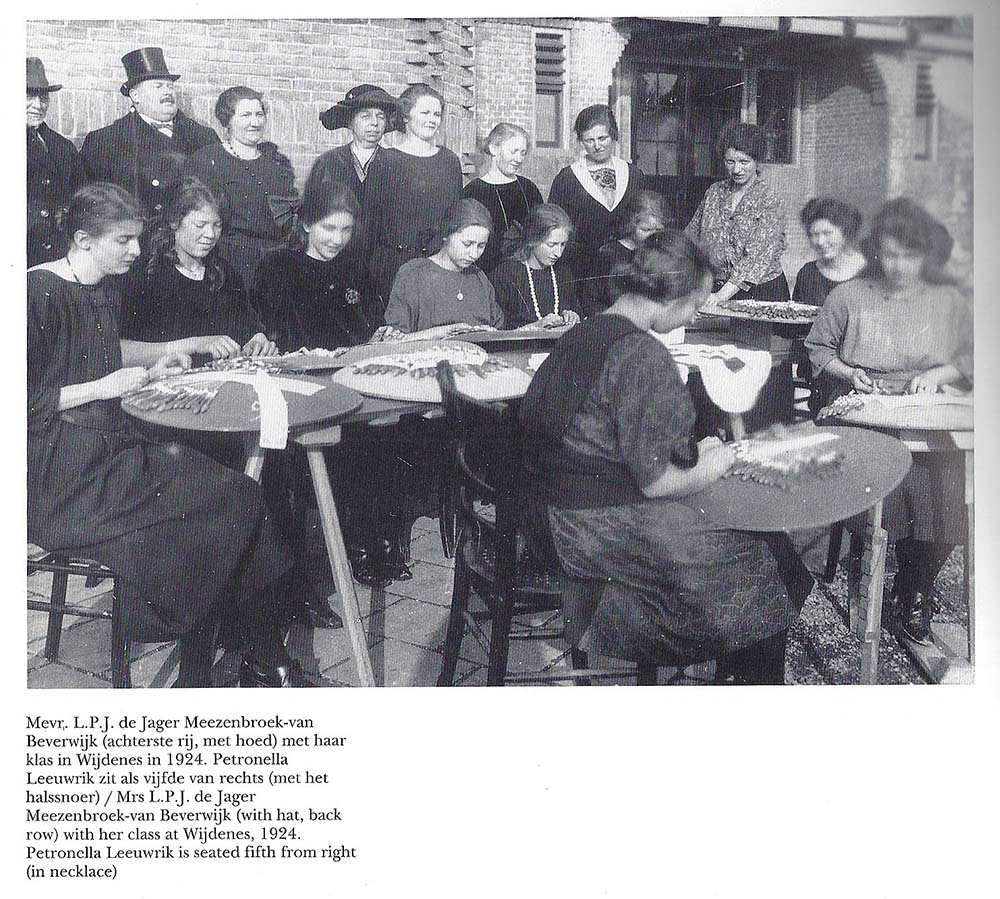
Mrs. L.P.J. de Jager Meezenbroek-van Beverwijk
Mrs L.P.J. de Jager Meezenrboek- van Beverwijk was an important lacemaker, teacher and designer in the Netherlands around 1920. She founded the lace school in Wijdenes and initiated the New Dutch Lace. This was a complete new approach of bobbin lace in that time.
Mrs. De Jager Meezenbroek was born on May 20, 1869 as Louise Pierette Jacqueline van Beverwijk. As a child she lived in Schijndel (Noord-Brabant) until she went to Amsterdam. There she studied at the Arts and Crafts School, Quellinus, near the Rijksmuseum. She graduated as a bobbin lace teacher.
In 1897 she married Rev. Nicolaas de Jager Meezenbroek, minister in Graft (Noord-Holland).
Besides being creative, she was also very intelligent. She translated several theological books from French, German, English and Norwegian into Dutch.
This shows her language skills, but also the the books for children she wrote, such as ‘The son of the aeronaut’ after a book written by Emma Kraft in Norwegian and ‘Whe Else was thirteen’.
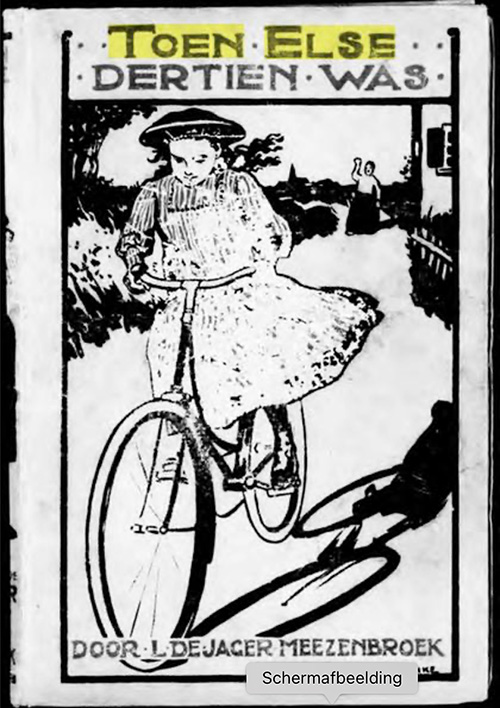 In 1914 she and her husband moved to Wijdenes, a little village in Noord-Holland, near the Zuiderzee, Soon after her arrival there she founded the school for lace making ‘Ieder voor allen’ (Everyone for all). The people in the village were quite prosperous and there was no need for the women to provide extra money for the maintenance of the family. Mrs. De Jager Meezenbroek thought that in wintertime there was not enough work for the women. They had to do something in order to be able to earn some extra money.
In 1914 she and her husband moved to Wijdenes, a little village in Noord-Holland, near the Zuiderzee, Soon after her arrival there she founded the school for lace making ‘Ieder voor allen’ (Everyone for all). The people in the village were quite prosperous and there was no need for the women to provide extra money for the maintenance of the family. Mrs. De Jager Meezenbroek thought that in wintertime there was not enough work for the women. They had to do something in order to be able to earn some extra money.
Until 1919 she was also the teacher on that school. Then she became the teacher for bobbin-lace at the same school on which she graduated before, the Arts and Crafts school Quellinus in Amsterdam.
Most of the laces made in that period, did not meet the very distinctive view of Mrs. De Jager Meezenbroek. These ‘old-fashioned’ laces often consisted of various motifs and according to her view contradicted this the developments of that time. She thought that the lace had to fullfill the technical and esthetical requirements of the time. As far as design was concerned, this came down to 'good proportions, strong lines, harmony and rhythm. Without that the design was not of any cultural value.
Then the geometrical principles of the Dutch architects as H.P. Berlage, K.P.C. de Bazel and Mathieu Lauwriks were used in the lace designs. Mrs. De Jager Meezenbroek was the first one, who did. She was heavily influenced by N.J. van der Vecht, art teacher at the State School of Applied Arts. He argued that the designs for the applied art should start from the surface that had to be embellished. That had to be divided first, then a rhythm was to be found and only then the motif could be designed. The motif was therefore subordinate to the application and not the other way around, which, according to Van der Vecht, belonged more to the visual arts. He pointed out that designing for applied art, such as bobbin lace, had to start from the material and technique to be used.
Following on from this, Mrs. De Jager Meezenbroek returns to the essence of the lace, namely threads that cross each other at right angles or obliquely and the gradations of contrast between the cloth stitch and the more open plaited grounds. These elements together with the geometric elements, such as squares, rectangles, circles, etc. formed the basis of her designs. So it was not a jumble of separate motifs, but a rhythmically structured, continious lace. A lot of her designs are completely geometrical, but also floral motifs are designed that way. Always the technique is clear, logical and always a remarkably simple dessign.
 Also characteristic of her designs is the way in which they were drawn. Deep black areas for the dense linen stitch and sometimes more open areas and clear lines for the braids, which made the lace into a whole.
Also characteristic of her designs is the way in which they were drawn. Deep black areas for the dense linen stitch and sometimes more open areas and clear lines for the braids, which made the lace into a whole.
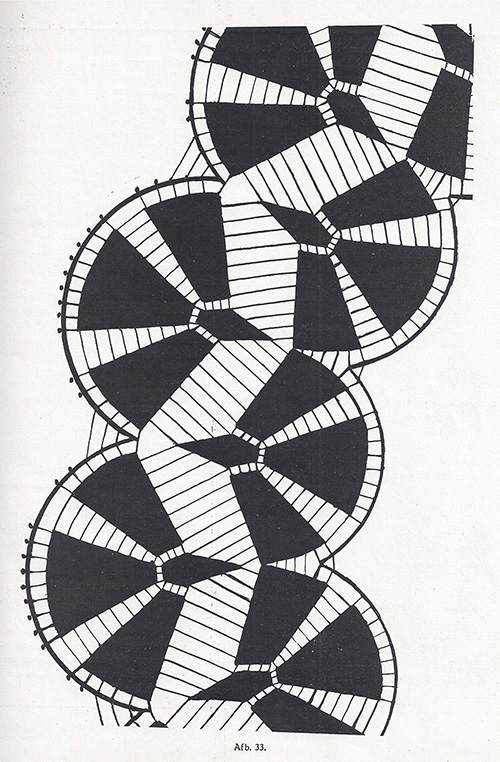 She was convinced of the quality of her designs and the path she went. So much convinced that she called her lace the New Dutch Lace.
Mrs. De Jager Meezenbroek wrote several lace books:
She was convinced of the quality of her designs and the path she went. So much convinced that she called her lace the New Dutch Lace.
Mrs. De Jager Meezenbroek wrote several lace books:
‘Het Leerboek voor het klossen van Kantwerk’ (the Studybook for making Bobbin lace) published about 1924 by Holkema en Warendorf
‘Kantklostechniek met eenvoudige voorbeelden’ (Technique of Bobbin lace with simple examples) published in 1935
‘Modern Kantklossen’ (Contemporary Bobbin lace) published in 1936 by Holkema en Warendorf
‘Kantklossen, techniek met eenvoudige voorbeelden’ (Bobbin lace, technique with simple examples) published in 1952 by ESKA
The first mentioned book is not only for to learn bobbin lace making but also for to learn to design bobbin lace.
In March 1932 a new organization was founded by among others Mrs. De Jager Meezenbroek,: De Kantnijverheid.(The Lace Industry) This aimed at promoting a specific Dutch product, training fully-fledged, independent lace workers and a production that benefits both the worker and the buyer. This organization was also committed to the promotion of the 'Nieuwe Hollandsche Kant'. As secretary and president, she periodically published a small newsletter. The organization also organized sales exhibitions. For this, the lace was inspected and provided with a card from the association on which the name of the maker and the price had to be stated.
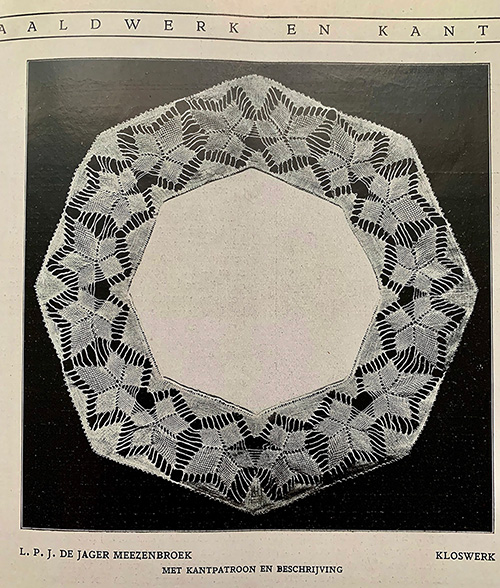 Following the fashion of that time the lace was not only made in white as before but also colors were used.
Following the fashion of that time the lace was not only made in white as before but also colors were used.
The lace school in Wijdenes still exists. Until when Mrs. De Jager Meezenbroek was the director of this, I have not been able to find anywhere. However, in 1919, when she became a lace teacher at the School of Applied Arts in Amsterdam, she stopped teaching in Wijdenes.
She died on November 20, 1961 in Amsterdam at the age of 92 years.
Sources:
Marjan de Groot: Vrouwen in de vormgeving in Nederland 1880-1940, Amsterdam 2000.
Kantklosschool “Ieder voor allen Wijdenes”.
Patricia Wardle: Nuttig en Nodig, Nederlandse Kantopleidingen 1850-1940
Hanneke Troost en Yvonne Krijgsman: Hollandsche Kant met passer en liniaal, LOKK 2008
This articlee was originally published in the OIDFA Bulletin nr. 3 -2022.
Mrs. De Jager Meezenbroek was born on May 20, 1869 as Louise Pierette Jacqueline van Beverwijk. As a child she lived in Schijndel (Noord-Brabant) until she went to Amsterdam. There she studied at the Arts and Crafts School, Quellinus, near the Rijksmuseum. She graduated as a bobbin lace teacher.
In 1897 she married Rev. Nicolaas de Jager Meezenbroek, minister in Graft (Noord-Holland).
Besides being creative, she was also very intelligent. She translated several theological books from French, German, English and Norwegian into Dutch.
This shows her language skills, but also the the books for children she wrote, such as ‘The son of the aeronaut’ after a book written by Emma Kraft in Norwegian and ‘Whe Else was thirteen’.
 In 1914 she and her husband moved to Wijdenes, a little village in Noord-Holland, near the Zuiderzee, Soon after her arrival there she founded the school for lace making ‘Ieder voor allen’ (Everyone for all). The people in the village were quite prosperous and there was no need for the women to provide extra money for the maintenance of the family. Mrs. De Jager Meezenbroek thought that in wintertime there was not enough work for the women. They had to do something in order to be able to earn some extra money.
In 1914 she and her husband moved to Wijdenes, a little village in Noord-Holland, near the Zuiderzee, Soon after her arrival there she founded the school for lace making ‘Ieder voor allen’ (Everyone for all). The people in the village were quite prosperous and there was no need for the women to provide extra money for the maintenance of the family. Mrs. De Jager Meezenbroek thought that in wintertime there was not enough work for the women. They had to do something in order to be able to earn some extra money.Until 1919 she was also the teacher on that school. Then she became the teacher for bobbin-lace at the same school on which she graduated before, the Arts and Crafts school Quellinus in Amsterdam.
Most of the laces made in that period, did not meet the very distinctive view of Mrs. De Jager Meezenbroek. These ‘old-fashioned’ laces often consisted of various motifs and according to her view contradicted this the developments of that time. She thought that the lace had to fullfill the technical and esthetical requirements of the time. As far as design was concerned, this came down to 'good proportions, strong lines, harmony and rhythm. Without that the design was not of any cultural value.
Then the geometrical principles of the Dutch architects as H.P. Berlage, K.P.C. de Bazel and Mathieu Lauwriks were used in the lace designs. Mrs. De Jager Meezenbroek was the first one, who did. She was heavily influenced by N.J. van der Vecht, art teacher at the State School of Applied Arts. He argued that the designs for the applied art should start from the surface that had to be embellished. That had to be divided first, then a rhythm was to be found and only then the motif could be designed. The motif was therefore subordinate to the application and not the other way around, which, according to Van der Vecht, belonged more to the visual arts. He pointed out that designing for applied art, such as bobbin lace, had to start from the material and technique to be used.
Following on from this, Mrs. De Jager Meezenbroek returns to the essence of the lace, namely threads that cross each other at right angles or obliquely and the gradations of contrast between the cloth stitch and the more open plaited grounds. These elements together with the geometric elements, such as squares, rectangles, circles, etc. formed the basis of her designs. So it was not a jumble of separate motifs, but a rhythmically structured, continious lace. A lot of her designs are completely geometrical, but also floral motifs are designed that way. Always the technique is clear, logical and always a remarkably simple dessign.
 Also characteristic of her designs is the way in which they were drawn. Deep black areas for the dense linen stitch and sometimes more open areas and clear lines for the braids, which made the lace into a whole.
Also characteristic of her designs is the way in which they were drawn. Deep black areas for the dense linen stitch and sometimes more open areas and clear lines for the braids, which made the lace into a whole. She was convinced of the quality of her designs and the path she went. So much convinced that she called her lace the New Dutch Lace.
Mrs. De Jager Meezenbroek wrote several lace books:
She was convinced of the quality of her designs and the path she went. So much convinced that she called her lace the New Dutch Lace.
Mrs. De Jager Meezenbroek wrote several lace books:‘Het Leerboek voor het klossen van Kantwerk’ (the Studybook for making Bobbin lace) published about 1924 by Holkema en Warendorf
‘Kantklostechniek met eenvoudige voorbeelden’ (Technique of Bobbin lace with simple examples) published in 1935
‘Modern Kantklossen’ (Contemporary Bobbin lace) published in 1936 by Holkema en Warendorf
‘Kantklossen, techniek met eenvoudige voorbeelden’ (Bobbin lace, technique with simple examples) published in 1952 by ESKA
The first mentioned book is not only for to learn bobbin lace making but also for to learn to design bobbin lace.
In March 1932 a new organization was founded by among others Mrs. De Jager Meezenbroek,: De Kantnijverheid.(The Lace Industry) This aimed at promoting a specific Dutch product, training fully-fledged, independent lace workers and a production that benefits both the worker and the buyer. This organization was also committed to the promotion of the 'Nieuwe Hollandsche Kant'. As secretary and president, she periodically published a small newsletter. The organization also organized sales exhibitions. For this, the lace was inspected and provided with a card from the association on which the name of the maker and the price had to be stated.
 Following the fashion of that time the lace was not only made in white as before but also colors were used.
Following the fashion of that time the lace was not only made in white as before but also colors were used.The lace school in Wijdenes still exists. Until when Mrs. De Jager Meezenbroek was the director of this, I have not been able to find anywhere. However, in 1919, when she became a lace teacher at the School of Applied Arts in Amsterdam, she stopped teaching in Wijdenes.
She died on November 20, 1961 in Amsterdam at the age of 92 years.
Sources:
Marjan de Groot: Vrouwen in de vormgeving in Nederland 1880-1940, Amsterdam 2000.
Kantklosschool “Ieder voor allen Wijdenes”.
Patricia Wardle: Nuttig en Nodig, Nederlandse Kantopleidingen 1850-1940
Hanneke Troost en Yvonne Krijgsman: Hollandsche Kant met passer en liniaal, LOKK 2008
This articlee was originally published in the OIDFA Bulletin nr. 3 -2022.
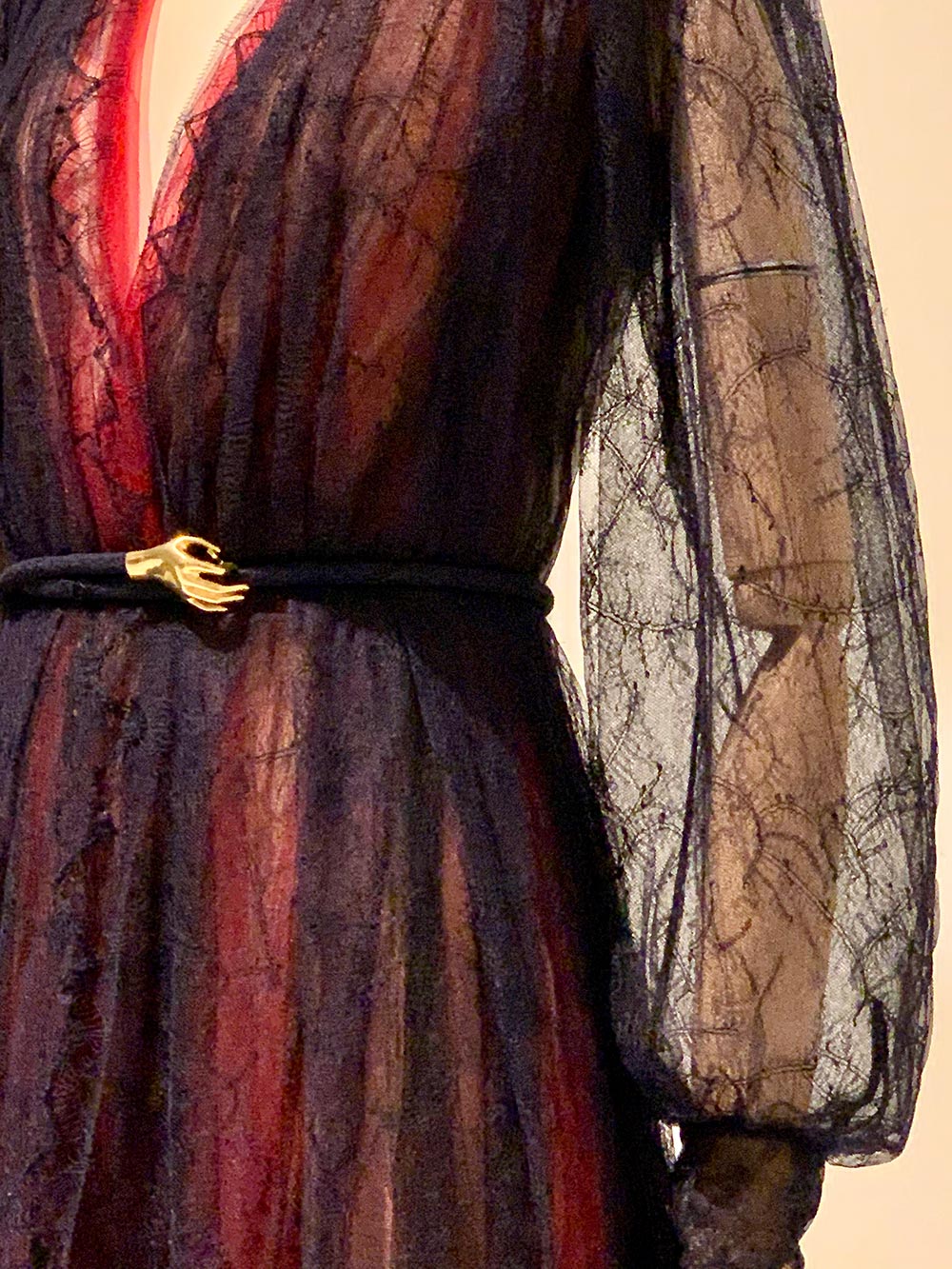
“Tears and Lace” of the Elsa Schiaparelli fashion house
When I read the recent TRC blog about Elsa Schiaparelli, I thought of the exhibition The Art of Lace (2020) in the TextileMuseum in Tilburg. This exhibition, adapted from an earlier exhibition called 'Haute Dentelle' mounted in Calais in 2018, was an ode to lace manufacturers, but also to the fashion houses that use lace. The curator then was Sylvie Marot.
The exhibition did not focus on handmade lace, but on machine made forms. The laces for the fashion industry were often specially designed and made for the couture houses. Lace factories, such as those of Solstiss in Caudry and Darquer Méry and Noyon Dentelles in Calais, still exist.
A number of Elsa Schiaparelli's dresses, with lace, were displayed in this exhibition. Schiaparelli's fashion house used different lace manufacturers. One of the dresses was made of lace and reflected a special story:
The design for the lace was based on a photograph from Rose-Lynn Fisher's series The Topography of Tears (2009). For this series, the artist studied her own tears through a microscope and took close-up photographs. The lace manufacturer Darquer had one of their lace designers, Vincent Fasquel, make a digital sketch of the photograph 'Last tear I ever cry for you', which was provided with a double scalloped edge by Fasquel's colleague, Frédéric Rumigny. Now the design was ready to be worked out by technical draftsmen for the machine. In 2015, a sample of the lace was made on their Leavers machine in the Chantilly technique.
 When the machine-made lace, by now called Tears and Lace, was presented to the Schiaparelli fashion house, they were immediately enthusiastic without knowing exactly the story of its origins.
The lace, black in colour, was used over a red dress belonging to the autumn-winter 2017/2018 collection. The dress was called 'Les vases communicants'. The tear drop pattern is very clearly visible on the sleeves, where the lace is almost undraped and therefore virtually transparent. The scalloped edges are clearly recognisable on the bottom edge and front of the dress.
When the machine-made lace, by now called Tears and Lace, was presented to the Schiaparelli fashion house, they were immediately enthusiastic without knowing exactly the story of its origins.
The lace, black in colour, was used over a red dress belonging to the autumn-winter 2017/2018 collection. The dress was called 'Les vases communicants'. The tear drop pattern is very clearly visible on the sleeves, where the lace is almost undraped and therefore virtually transparent. The scalloped edges are clearly recognisable on the bottom edge and front of the dress.
This article was originally publised on the TRC Blog on 31 december 2021.
A number of Elsa Schiaparelli's dresses, with lace, were displayed in this exhibition. Schiaparelli's fashion house used different lace manufacturers. One of the dresses was made of lace and reflected a special story:
The design for the lace was based on a photograph from Rose-Lynn Fisher's series The Topography of Tears (2009). For this series, the artist studied her own tears through a microscope and took close-up photographs. The lace manufacturer Darquer had one of their lace designers, Vincent Fasquel, make a digital sketch of the photograph 'Last tear I ever cry for you', which was provided with a double scalloped edge by Fasquel's colleague, Frédéric Rumigny. Now the design was ready to be worked out by technical draftsmen for the machine. In 2015, a sample of the lace was made on their Leavers machine in the Chantilly technique.
 When the machine-made lace, by now called Tears and Lace, was presented to the Schiaparelli fashion house, they were immediately enthusiastic without knowing exactly the story of its origins.
The lace, black in colour, was used over a red dress belonging to the autumn-winter 2017/2018 collection. The dress was called 'Les vases communicants'. The tear drop pattern is very clearly visible on the sleeves, where the lace is almost undraped and therefore virtually transparent. The scalloped edges are clearly recognisable on the bottom edge and front of the dress.
When the machine-made lace, by now called Tears and Lace, was presented to the Schiaparelli fashion house, they were immediately enthusiastic without knowing exactly the story of its origins.
The lace, black in colour, was used over a red dress belonging to the autumn-winter 2017/2018 collection. The dress was called 'Les vases communicants'. The tear drop pattern is very clearly visible on the sleeves, where the lace is almost undraped and therefore virtually transparent. The scalloped edges are clearly recognisable on the bottom edge and front of the dress.This article was originally publised on the TRC Blog on 31 december 2021.